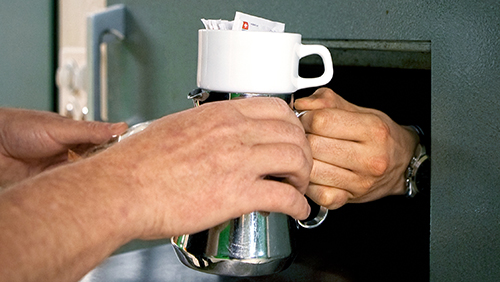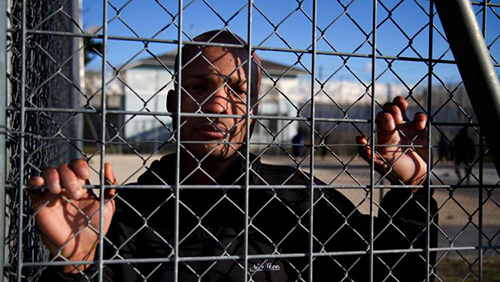Maintaining Distance and Producing Indifference in Swiss Immigration Detention

In contrast to many other countries, Switzerland confines most of its immigration detainees in ordinary prisons together with convicted or on remand prisoners – although usually in separated areas. As a consequence, prison officers are those in charge of the confinement and exclusion of migrants. They are constantly confronted with their suffering, which may take the form of bewilderment, anger, or despair, and develop forms of moral detachment to cope with the situation.
The daily interactions between prison officers and detained migrants could result in a constructive encounter where both could learn something from each other’s trajectories and experiences. However, I observed that such meaningful contacts are averted in many ways in the daily life and work in detention. When prison officers open or close doors, when they deliver meals or any other goods, when they accompany detainees through the prison space, very often there is hardly any communication. In this post, I reflect on the relationship between staff and detainees drawing on my ethnographic research in two Swiss prisons, which confine migrants pending deportation.
Interacting in the Carceral Space: Material and Administrative Barriers
Doors, bars, glass walls: the whole prison space has the function of separating bodies and distinguishing between those detained and those detaining. The specific material and spatial configurations of the prison also shape the ways in which individuals interact with each other. In one of the two prisons where I conducted empirical research, most interactions between staff and detainees occurred through a porthole in the cell’s door, which prevented them from seeing the whole body of the other person. The person behind the door was then reduced to a hand, a fragment of a face, or a voice, making it difficult to acknowledge him or her as a full person with feelings and opinions. Hence, the porthole acted as a physical barrier to communication, and also had a dehumanizing effect.
Photo: Marco Zanoni
Other barriers are less visible but nevertheless powerful in their impact to prevent a relationship of empathy from developing, such as the forms that detainees must use to make any request. The rotation of staff members between different detention sections is another of those measures described as “institutional tactics” that facilitate moral distance. Its function of creating distance is actually desired by the prison director, who argued: “We do not want to create any close relationship, because we do not offer a therapeutic setting, and we do not work with a system of reference persons.”
Maintaining Distance – or the Institutional Production of (In)Difference
The institutional roles attributed to staff and detainees by the prison also contribute to producing distance. Prison staff wear uniform and carry the keys, while detainees find themselves locked up by staff. This difference in roles and power is in itself a barrier and makes it difficult for an empathic relationship to develop. Furthermore, the institution requires from prison officers a “professional” conduct, meaning that they have to behave according to their institutional role as well as to internal regulations, which provide detailed guidance on how to address detainees or shake hands in appropriate ways.
Despite the material barriers and institutional mechanisms, which serve to maintain a distance between the two groups, the emergence of empathy among employees is frequent. But empathy is also a source of frustration for prison staff and its emergence is sometimes prevented by the officers’ need of estrangement, as this employee describes: “I feel sorry for her [detainee], I find it so bad [that she is sent back to Hungary]. But… I can’t help her, yes, I cannot do much and in general, yes, you are quickly a bit hardened. (…) you see it so much, you see it every day, it becomes almost normal. You can’t really do anything.” Simply explained by this prison officer, the “overexposure to suffering” produces a normalization of suffering.
Furthermore, the position of the prison at the margins of the deportation system makes it easier for prison officers to detach themselves from the individual pains and fates of detainees. Without any decision-making power, they often lack any knowledge of the personal situations of detainees.
Making Sense of Immigration Detention
The use of prisons for immigration detention is a meaningful policy with important consequences. Prison architecture and logics impact the everyday practices and experiences of detention, while migrants are practically and symbolically criminalized. In addition, the confinement of migrants pending deportation together with people accused or convicted of crimes also influences detainees’ and staff’s mutual representations as well as their understandings of immigration detention.
According to the law, immigration detainees must be held separately from other detainees. However, the degree of separation ranges widely from one facility to another and very often “migrants” and “criminals” are confined in almost identical spaces and conditions. The fact that detention staff work on rotation in different prison wings and thus with different types of detainees causes confusion among prison officers. They know the difference between different types of detention, but regardless of whether detainees are convicted of a crime or awaiting deportation, their tasks are practically the same.
Picture from the film “Special Flight” (2011) by Fernand Melgar
In this context, it is not surprising that prison officers rely on the confusion between penal and administrative detention to make sense of the category of immigration detainees. Indeed, staff often highlight that detainees “are not criminal, but… they are illegal”, implicitly relating the illegality of their stay to the illegality of crimes committed by other prisoners. But illegality as a category of law is often accompanied by illegitimacy as a moral category. Detention is then understood within a state system which sorts “true” refugees from “bogus” asylum seekers and legitimate from illegitimate migrants. Those who end up in detention must then inevitably be the “undeserving” ones. In this way, the institutionalized dichotomy between refugees and economic migrants is internalized and mobilized in order to justify the system of detention and deportation, along with the representation of Switzerland as fair and generous with the “deserving” ones. Furthermore, the unknown past and the contested identity of certain detainees make them more suspect and potentially threatening in the eyes of staff, strengthening their moral estrangement.
Laura Rezzonico
Doctoral student, nccr – on the move, University of Neuchatel
This is a shortened version of a post of Border Criminologies’ themed series on “Exploring the Everyday of Immigration Detention” organized by Annika Lindberg, University of Bern, and Laura Rezzonico, University of Neuchatel and nccr – on the move. It was originally published on 4 December 2017. The series brings together insights on the everyday of immigration detention, which has become a normalized part of the deportation regime and is one of many instruments used by states to discipline, control and deport “undesirable” migrants from their territory.




